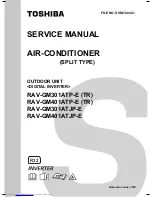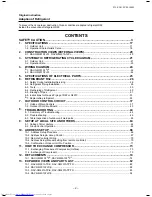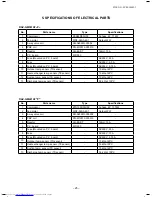
Refrigerant R32
This air conditioner adopts a new HFC type refrigerant (R32) which does not deplete the ozone layer.
1. Safety Caution Concerned to Refrigerant R32
Be sure that water, dust, the former refrigerant or the former refrigerating oil is not mixed into the
refrigerating cycle of the air conditioner with refrigerant R32 during installation work or service work.
If an incorrect work or incorrect service is performed, there is a possibility to cause a serious accident.
Use the tools and materials exclusive to R32 to purpose a safe work.
2. Safety and Cautions on Installation/Service
<Safety items>
When gas concentration and ignition energy are happened at the same time,
R32 has a slight possibility of burning. Although it will not ignite under normal work
environment conditions, be aware that the flame spreads if ignition should occur.
It is necessary to carry out installation/servicing safely while taking the following
precautions into consideration.
1) Never use refrigerant other than specified refrigerant (R32) in an air conditioner which is designed
to operate with the specified refrigerant (R32).
If other refrigerant than R32 is used, it may cause personal injury, etc. by a malfunction,
a fire, a rupture.
2) Since R32 is heavier than air, it tends to accumulate on the bottom (near the floor).
Ventilate properly for the working environment to prevent its combustion.
Especially in a basement or a closed room where is the high risk of the accumulation,
ventilate the room with a local exhaust ventilation.
If refrigerant leakage is confirmed in the room or the place where the ventilation is insufficient,
do not work until the proper ventilation is performed and the work environment is improved.
3) When performing brazing work, be sure to check for leakage refrigerant or residual refrigerant.
If the leakage refrigerant comes into contact with fire, a poisonous gas may
occur or it may cause a fire. Keep adequate ventilation during the work.
4) When refrigerant gas leaks during work, execute ventilation. If the leakage refrigerant comes into
contact with a fire, a poisonous gas may occur or it may cause a fire.
5) In places where installing / repairing air-conditioning equipment, etc., keep the source
of ignition such as gas combustion equipment, petroleum combustion equipment,
electric heater etc. away. Do not smoke in the place.
6) When installing or removing an air conditioner, do not mix air in the refrigerant cycle.
If air or others is mixed with the refrigerant, abnormal high pressure generates in the refrigerating
cycle, causing injury due to the breakage.
7) After installation work complete, confirm that refrigerant gas is not leaking on the flare
connection part or others. If leaked refrigerant comes to contact with a fire,
toxic gas may occur, causing a fire.
8) Perform the installation work and re-installation according to the installation manual.
Pay attention especially to the area of application. Improper installation may cause
refrigeration trouble or water leakage, electric shock and fire etc.
9) Unauthorized modifications to the air conditioner may be dangerous. If a breakdown
occurs please call a qualified air conditioner technician or electrician.
Improper repair may result in water leakage, electric shock and fire, etc.
10)Carry out the airtight test with nitrogen at a specified pressure. Do not use oxygen or
acetylene gas absolutely as it may cause an explosion.
11)Always carry a refrigerant leakage detection sensor during the work and work while
checking that no refrigerant leaks around working environment.
12)If the leakage refrigerant comes into contact with fire, it may cause a fire.
Have a dry powder or CO
2
fire extinguisher adjacent to the charging area.
FILE NO. SVM-18042
– 1
4
–















































